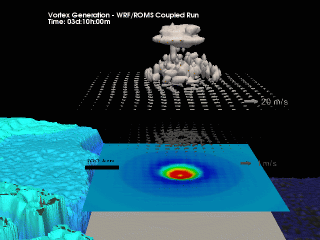Initial results of coupling the Weather Research and Forecasting model (WRF) with the Regional Ocean Model System (ROMS) as part of the Modeling Environment for Atmospheric Discovery (MEAD) project at the National Center for Supercomputing Alliance show interesting features in a project studying the physics of hurricane development. Initial studies of hurricane intensification were made without the coupled ocean model.
The MEAD coupling scheme allows the comparison to runs made running on the coupled WRF/ROMS system. The coupling scheme and software design will be presented as well as a comparison of runs with and without the ocean. The coupling scheme was designed as part of the MEAD project, and involves coupling WRF and ROMS over a computational grid using Globus middleware and a the Model Coupling Toolkit (MCT). MCT consists of a set of distributed-memory routines based on MPI and developed at Argonne National Labs. The initial runs were made on a 768-node Intel Pentium cluster at NOAA's Forecast Systems Laboratory, and use an atmospheric domain of 321 by 321 lateral points and 30 levels spanning a 1288km square grid initialized to a "background" sounding representing the mean hurricane season in the Caribbean. The ocean domain is 400 by 400 horizontal points by 30 in the vertical, and initialized with a temperature stratification typical of the tropical Atlantic. A sparse matrix is generated using the Spherical Coordinate Remapping and Interpolation Package (SCRIP) that allows the coupling API to do a conservative remapping between domains. The atmosphere (WRF) provides wind stresses, heat, and evaporation minus precipitation to the ocean (ROMS), and the resulting sea-surface temperature is sent back to WRF.
WRF and ROMS are time-stepped at 1-minute, and 5-minutes respectively, and coupled every 10 minutes. The load balancing for this concurrent run required 8 processors modeling the atmosphere for every oceanic processor. Boundary conditions at the air-sea interface are exchanged between clusters at two different locations using the Globus toolkit. Initial runs were coupled between machines at two NOAA labs over the Abilene network connection, and subsequent studies were done on the TeraGrid using clusters at NCSA and Argonne National Labs.
Vortex generation is modeled by initiating a tropical storm-like vortical wind field in gradient wind balance. Unbalanced thermal perturbations caused by asymmetric bursts of convection in the vicinity of the vortex cause localized accelerations of the symmetric vortex via eddy momentum and heat fluxes. Fluxes of heat and moisture are the energy source for the convection that drives the storm, and coupling the atmospheric vortex model to a primitive equation ocean model allows the investigation of ocean-atmosphere interactions that control hurricane intensity.
Source code for both models, as well as coupling code (using MCT) and directions for their use can be downloaded as a gzipped tar archive. Please contact me at Christopher.Moore@noaa.gov if there are questions about running the code.
